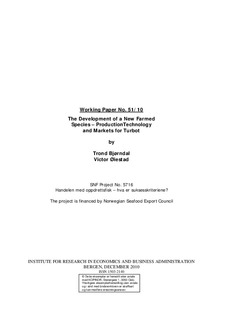| dc.description.abstract | Turbot (Scophthalmus maximus) is a high value fish that is much favoured in many market segments such as white tablecloth restaurants. Aquaculture of turbot started first in Scotland in the 1970s, but from the early 1980s the expansion in production volume and number of farms took place in Galicia, Spain. Still the main production takes place in Galicia with modest culture in France, Portugal, Denmark, Germany, Iceland, Ireland, Italy, Norway and Wales. This picture may change due to plans for substantial expansion of production in Portugal. As a consequence, aquaculture’s share of the market will dominate compared to the contribution from the wild fishery. The purpose of this report is to analyse current developments and make a forecast of future trends in turbot production and markets. There are important developments in farming technology that may impact on future supply and cost of production. On this background, we will analyse the future sustainability of turbot farming from a technological as well as economic point of view. | en |
